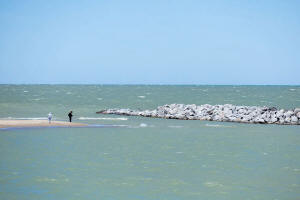Illinois state parks draw highest number of visitors in more than a
decade
[May 10, 2025]
By Ben Szalinski
SPRINGFIELD – Illinois state parks saw more visitors in 2024 than any
point in the past 15 years, according to new data from the Illinois
Department of Natural Resources.
Illinois’ 290 state parks and 56 historic sites recorded more than 41
million visitors last year, which was the most in 15 years, following
several significant capital projects to upgrade and improve many of the
parks.
Interest in state parks has been growing since the pandemic, IDNR
Director Natalie Phelps Finnie said in an interview.
“During COVID, people were stir crazy, shut in, and they once again
realized how important nature is to all of us,” Phelps Finnie said.
An aggressive advertising campaign by the state has also helped, she
said. The Illinois Department of Commerce and Economic Opportunity
launched the state’s “Middle of Everything” marketing campaign in 2022,
which promotes tourism at the state’s top recreation and cultural
attractions in TV commercials, billboards and online advertising.
Starved Rock State Park in LaSalle County topped the list in 2024 with
2.4 million visitors coming to explore the canyons and waterfalls
nestled in gorges along the Illinois River in north-central Illinois.
The second-most visited park last year was Illinois Beach State Park,
near Zion, with 2 million visitors. IDNR completed a major $73 million
project last year to preserve the park from erosion.

“It’s always been a high number of visitors, but certainly the uptick
we’ve seen since the beach was restored and since the resort is being
invested in once again and remodeled,” Phelps Finnie said.
Beach State Park holds Illinois’ only undeveloped stretch of Lake
Michigan shoreline, but it’s subject to the ferocious waves of the lake.
The conditions have sometimes eroded up to 100 feet of shoreline a year
in parts of the park.
To preserve the park’s shoreline, IDNR’s project included building 22
breakwater structures in the lake to decrease the power of the waves
hitting the shore. Several of the structures are entirely submerged
while others that poke out the surface of the lake are designed to
provide nesting for migratory birds.
The project also included extending the public beach further into Lake
Michigan. Erosion had diminished the beach to come within feet of the
parking lot and hotel at the park.
[to top of second column]
|

Two people fish on a beach at Illinois Beach State Park near one of
22 breakwaters which protect the shoreline from erosion. (Capitol
News Illinois photo by Andrew Adams)

The state also announced earlier this year it will put $60 million
toward deferred maintenance projects. More than half of that will go to
Starved Rock for trail improvements, facility renovations and building a
new wastewater system.
The department is also working on adding electric vehicle chargers at
state parks and renovating the Old State Capitol in Springfield.
This summer, IDNR plans to restore and upgrade the Crenshaw House in
Gallatin County to include a visitor center at a location on the reverse
underground railroad, where slaves were held. According to IDNR, John
Crenshaw used slaves at his southern Illinois home where he manufactured
salt. Crenshaw is also believed to have kidnapped freed or escaped
slaves to sell them back to slavery in the South.
“We’re excited that the investment is being made and these parks are
getting the attention they deserve,” Phelps Finnie said.
Lincoln’s New Salem Historic Site in Peterburg, where the 16th president
lived in his 20s, was the state’s most visited historic site last year
with 360,000 visitors. The site is in line for funding to repair aging
buildings.
IDNR announced in March it will invest $8 million to repair up to 23
replica log buildings at the site that depict how the village looked
when Lincoln lived there in the 1830s.
“You have things fall into disrepair and then it dominoes,” Phelps
Finnie said. “It builds. So what was once maybe $100 million or so is
now a little over $1 billion worth of deferred maintenance” across
IDNR’s properties.
Capitol News Illinois is
a nonprofit, nonpartisan news service that distributes state government
coverage to hundreds of news outlets statewide. It is funded primarily
by the Illinois Press Foundation and the Robert R. McCormick Foundation.
 |